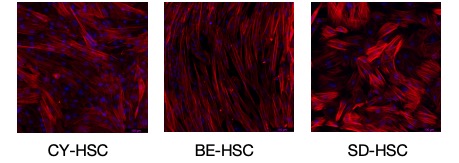
Share Important Moment of MileCell Bio with You
2025.04.03
Hepatic stellate cells (HSCs) are specialized intralobular cells exhibiting dual phenotypes as myofibroblast-like cells or vitamin A-storing lipocytes. They play central roles in maintaining extracellular matrix (ECM) homeostasis, liver repair, regeneration, and retinol metabolism. Upon liver injury, HSCs transdifferentiate into activated myofibroblasts, becoming the primary source of collagen type I deposition in hepatic fibrosis. Beyond ECM modulation, HSCs regulate hepatic microcirculation through contractile activity and contribute to intrahepatic portal hypertension in chronic liver diseases. Their proliferation, migration, and chemokine secretion further drive liver inflammation and fibrogenesis. Advances in understanding HSC activation mechanisms, such as TGF-β/Smad, Wnt/β-catenin, and redox signaling pathways, offer promising therapeutic targets to mitigate fibrosis and improve outcomes in chronic liver injury.
HSC from MileCell Bio
MileCell Bio’s Animal Hepatic Stellate Cells (HHSteC) are isolated from rat, mouse, dog, monkey liver tissue. Each vial contains 0.5 million cells in 1 mL volume.
Characterization:
1. Immunofluorescence Staining of α-smooth muscle actin (α-SMA)

Positive for α-smooth muscle actin (α-SMA) via immunofluorescence, confirming activation potential.
2. Photomicrograph

Proliferative capacity: Limited proliferation in vitro.
